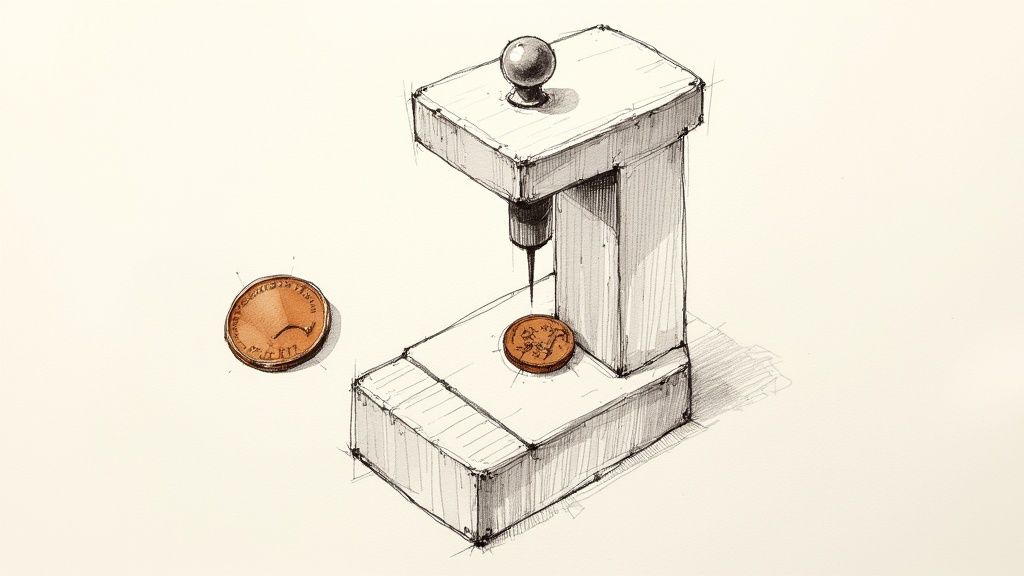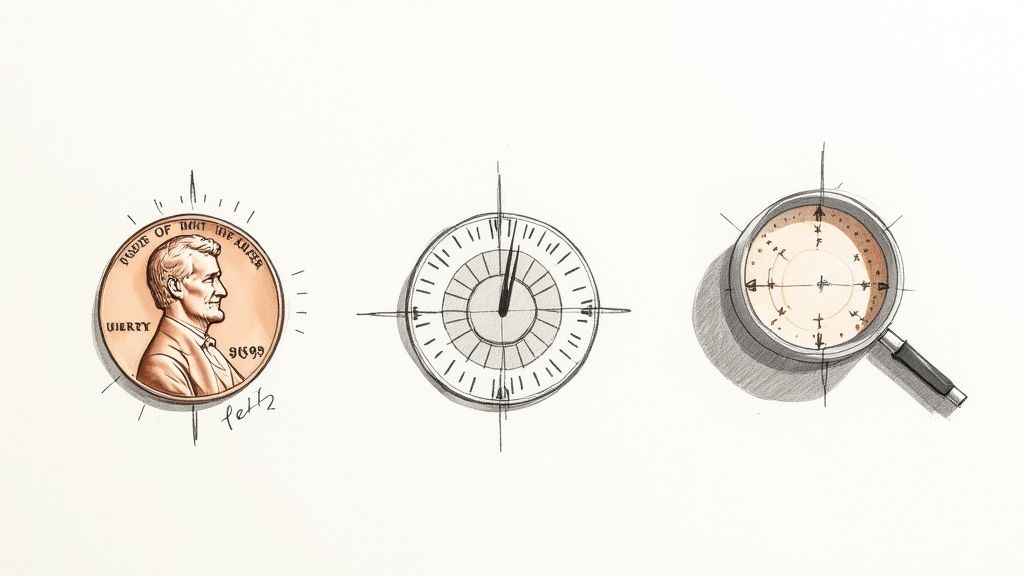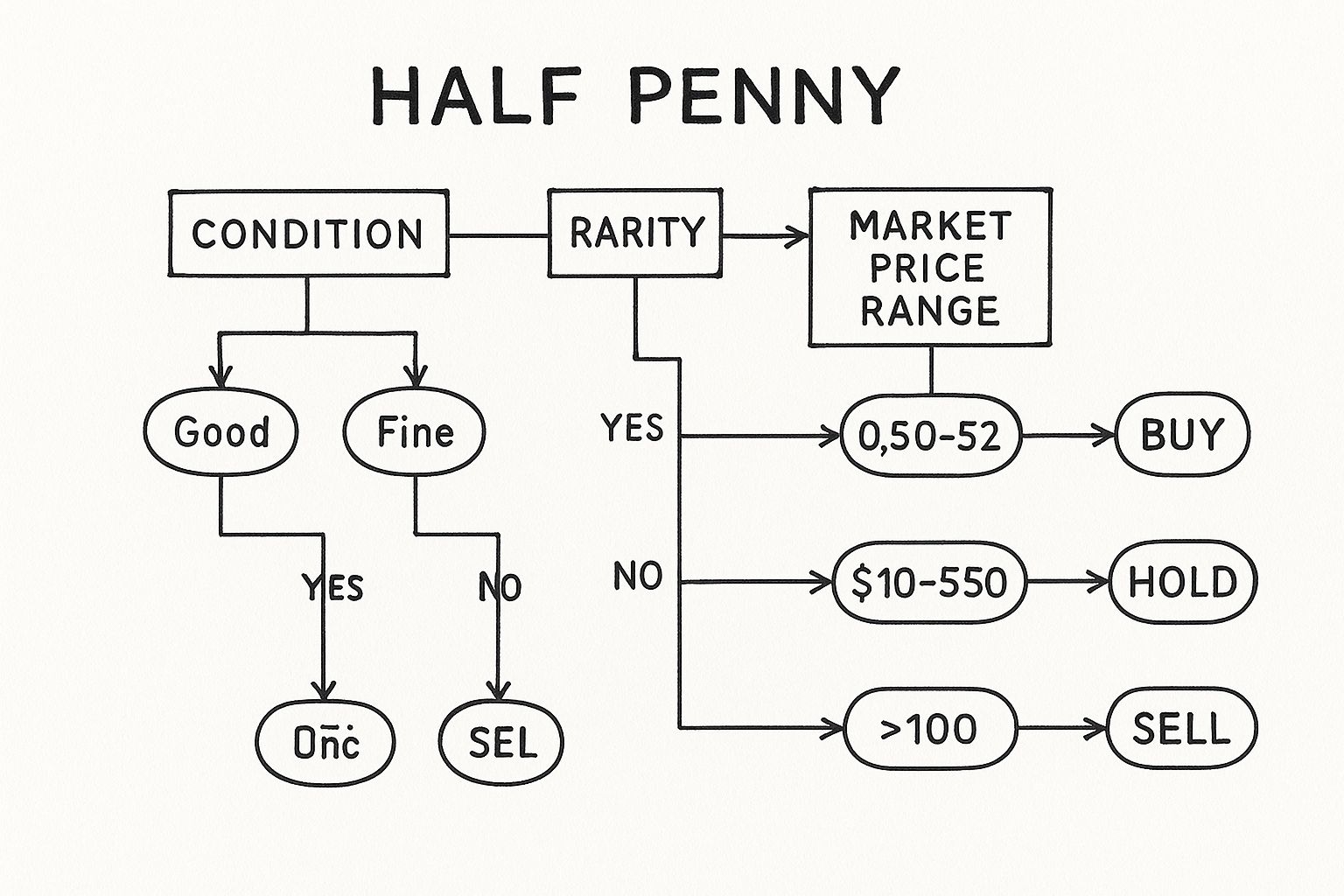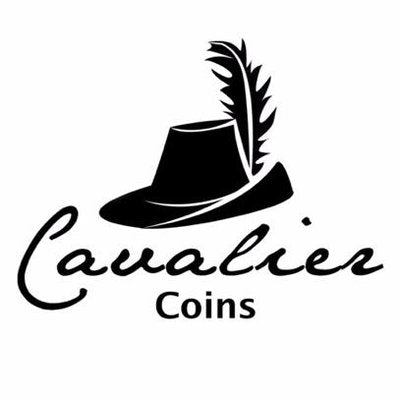That old half penny rattling around in your change jar might be more than just a forgotten coin. It could be a little piece of history with a surprisingly hefty price tag. While most decimal half pennies from recent decades are worth very little, older versions or coins in exceptional condition can be exactly what collectors are searching for. The trick is knowing what you've got.
Your Half Penny Could Be a Hidden Treasure
This guide will walk you through exactly how much a half penny is worth, shining a light on the crucial factors that can turn a common piece of shrapnel into a sought-after collectible. Figuring out its value is about more than just reading the date; it's a mix of the coin's history, its physical state, and just how many of them are still out there.
We'll dig into:

- Historical Context: Why older coins nearly always have a story to tell—and a higher value.
- Grading Criteria: How the condition, from battered to brilliant, can make or break the price.
- Rarity Factors: Pinpointing those key dates and quirky minting errors that collectors go mad for.
Think of it like this: a half penny from the 1980s is as common as a pebble on a beach. But stumbling upon a rare, well-preserved Victorian half penny? That's like finding a diamond in the sand.
A Journey Through The Half Penny's History

Before you can really get a handle on what your half penny is worth today, you have to understand where it's been. This wasn't just a piece of loose change; for centuries, this little coin was an absolute cornerstone of daily life across Britain.
Its story actually begins long before the first official half pennies were ever struck. Back in medieval times, the only way to make small change was to literally chop a silver penny in half or even into quarters. It was a practical solution that paved the way for the coin we know today.
That shift away from precious metals is a massive part of its story and directly impacts its value to collectors. The British halfpenny, once valued at 1/480th of a pound, eventually moved from silver to cheaper base metals like bronze. Why? The price of silver simply got too high.
This transition from silver to bronze is a crucial chapter, and you can dive deeper into this fascinating evolution in our brief history of British coins.
Grading Your Half Penny Like a Professional
When it comes to coin collecting, one thing rules them all: condition. Think of it like a classic car. A battered old motor that’s seen better days won't fetch much, but the same model kept in showroom condition is a different story entirely. It’s the same with coins.
A heavily worn half penny might just be worth its weight in copper, but find one in pristine, uncirculated condition, and its value could skyrocket by hundreds of times. Knowing how to judge its state is absolutely crucial to figuring out what your half penny is worth.

Collectors have a specific language for this, with grades ranging from "Good" (which, ironically, means heavily worn) all the way up to "Uncirculated" (meaning it looks like it just left the mint). The first details to vanish with wear are usually the high points, like the monarch’s portrait, and that lovely original mint lustre.
Getting a feel for grading takes a bit of practice, but it's a skill you can definitely learn. For a much closer look at what the professionals look for, check out our detailed expert guide to British coin grading.
Identifying Rare Half Pennies and Key Dates
As any seasoned collector will tell you, not all halfpennies are created equal. The real thrill of the hunt lies in finding those rare dates where the mint produced far fewer coins than usual.
Think of it like a first-edition book versus a mass-market paperback. Some years had incredibly low mintages, turning an ordinary coin into a prized find. Key dates from the Victorian era or certain scarce issues from the early 20th century, for example, will always command much higher prices.
This quick guide should help you decide whether a coin is a keeper, a seller, or one to hold onto.

As you can see, the sweet spot for value is where rarity and condition meet. An uncirculated coin from a scarce year is the ultimate goal.
Beyond the date, you also need to keep a sharp eye out for minting errors. These are the happy accidents of coin production—things like off-centre strikes or doubled lettering. These fascinating anomalies can instantly transform a common, everyday coin into a valuable and sought-after rarity.
A Practical Guide to Valuing UK Half Pennies
So, you've got a half penny and you're wondering what it's worth. For most 20th-century halfpennies, the answer really boils down to two things: its date and, most importantly, its condition.
If you’ve got a handful of old half pennies from the reigns of George V through to Elizabeth II, they’re most likely common coins. In circulated, well-worn condition, their value is quite minimal. They’re fantastic little pieces of history you can hold in your hand, but they aren't the sort of thing that will make you rich.
But here’s where things get interesting. The story completely changes if you happen to find one in uncirculated condition. A coin that has never seen a day of use, retaining all its original mint lustre and sharp, crisp details, is a different beast entirely. It's what collectors dream of.
For instance, a standard 1963 halfpenny that's been rattling around in pockets and tills might only fetch 10p to 50p. However, find a perfect, untouched version of that same coin, and its value can jump to between £3 and £5. That's a huge difference! You can see more examples of how condition impacts halfpenny values over at BullionByPost.co.uk.
This massive gap in value really hammers home just how critical condition is, not just for half pennies, but for identifying any valuable coins worth money.
Estimated Values for 20th Century Half Pennies
To give you a clearer picture, here's a rough guide to what you might expect for some of the more common 20th-century half pennies. Remember, these are just estimates, and the actual market value can fluctuate.
| Monarch / Era | Circulated Value | Uncirculated Value |
|---|---|---|
| George V (1911-1936) | 50p - £2 | £10 - £40+ |
| George VI (1937-1952) | 20p - £1 | £5 - £20 |
| Elizabeth II (Pre-Decimal) | 10p - 50p | £2 - £10 |
As you can see, even for common dates, a coin in pristine, uncirculated condition is always going to be worth significantly more than one that's been passed from hand to hand.
Half Penny Value: Your Questions Answered
Got questions about the value of your half pennies? You're not alone. We often get asked about specific dates, grading quirks, and what really makes one of these old coins valuable.
So, let's dive into some of the most common queries we see. Think of this as a quick guide to help you get a better handle on what your half penny might be worth.

